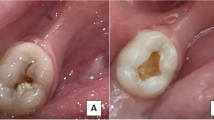Abstract
Carisolv is a minimally invasive method for softening and removing dentine caries. A new, modified Carisolv gel has been developed in order to optimise the efficiency if its chemical caries dissolution. The aim of the present study was to compare the caries removal efficiency of the original gel with that of the new gel, which contains almost double the concentration of sodium hypochlorite. Ten dentists treated 202 cavities in 170 patients; 104 cavities were randomised to the new gel and 98 to the original gel. Their mean treatment times for caries removal were 6.7±4.1 min and 7.6±4.2 min, respectively (P>0.05). In close-to-pulp lesions, constituting 32% of the cavities, the mean times for caries removal were 9.0±7.0 min and 11.6±4.4 min for the new and original gels, respectively (P<0.01). Questionnaires revealed that 81% of the patients preferred chemomechanical treatment to drilling. In conclusion, the improved efficiency of the modified Carisolv gel did reduce the time for caries removal in deep lesions. However, it still needs more time than conventional drilling.
Similar content being viewed by others
References
Ansari G, Beeley JA, Fung DE (2003) Chemomechanical caries removal in primary teeth in a group of anxious children. J Oral Rehabil 30: 773–779
Anusavice KJ, Kincheloe JE (1987) Comparison of pain associated with mechanical and chemomechanical removal of caries. J Dent Res 66: 1680–1683
Arvidsson A, Stirling C, Sennerby L, Wennerberg A (2001) Reactions in the oral mucous membrane after exposure to Carisolv™—combined results from a clinical screening test in humans and an experimental study in rats. Gerodontology 18: 109–113
Banerjee A, Kidd EAM, Watson TF (2000) In vitro evaluation of five alternative methods of carious dentine excavation. Caries Res 34: 144–150
Chaussain-Miller C, Decup F, Domejean-Orliaguet S, Gillet D, Guigand M, Kaleka R, Laboux O, Lafont J, Medioni E, Serfaty R, Toumelin-Chemla F, Tubiana J, Lasafargues JJ (2003) Clinical evaluation of the Carisolv chemomechanical caries removal technique according to the site/stage concept, a revised caries classification system. Clin Oral Invest 7: 32–37
Dammaschke T, Stratmann U, Mokrys K, Kaup M, Ott KHR (2001) Histocytological evaluation of the reaction of rat pulp tissue to Carisolv. J Dent 29: 283–290
Dammaschke T, Stratmann U, Mokrys K, Kaup M, Ott KHR (2002) Reaction of sound and demineralised dentine to Carisolv in vivo and in vitro. J Dent 30: 59–65
Ericson D, Zimmerman M, Raber H, Götrick B, Bornstein R, Thorell J (1999) Clinical evaluation of efficacy and safety of a new method for chemomechanical removal of caries. Caries Res 33: 171–177
Fure S, Lingström P, Birkhed D (2000) Evaluation of Carisolv™ for the chemomechanical removal of primary root caries in vivo. Caries Res 34: 275–280
Hannig M (1999) Effect of Carisolv™ solution on sound, demineralized and denatured dentin—an ultrastructural investigation. Clin Oral Invest 3: 155–159
Kakaboura A, Masouras C, Staikou O, Vougiouklakis G (2003) A comparative clinical study on the Carisolv caries removal method. Quintessence Int 34: 269–271
Lager A, Thornqvist E, Ericson D (2003) Cultivable bacteria in dentine after excavation using rose-bur or Carisolv. Caries Res 37: 206–211
Maragakis GM, Hahn P, Hellwig E (2001) Clinical evaluation of chemomechanical caries removal in primary molars and its acceptance by patients. Caries Res 35: 205–210
Munshi AK, Hegde AM, Shetty PK (2001) Clinical evaluation of Carisolv in the chemico-mechanical removal of carious dentine. J Clin Pediatr Dent 26: 49–54
Nadanovsky P, Cohen Carneiro F, Souza de Mello F (2001) Removal of caries using only hand instruments: a comparison of mechanical and chemomechanical methods. Caries Res 35: 384–389
Rafique S, Fiske J, Banerjee A (2003) Clinical trial of an air-abrasion/chemomechanical operative procedure for the restorative treatment of dental patients. Caries Res 37: 360–364
Splieth C, Rosin M, Gellissen B (2001) Determination of residual dentine caries after conventional mechanical and chemomechanical caries removal with Carisolv. Clin Oral Invest 5: 250–253
Wennerberg A, Sawase T, Kultje C (1999) The influence of Carisolv™ on enamel and dentine surface topography. Eur J Oral Sci 107: 297–306
Yazici AR, Atílla P, Özgünaltay G, Müftüoglu S (2003) In vitro comparison of the efficacy of Carisolv™ and conventional rotary instrument in caries removal. J Oral Rehabil 30: 1177–1182
Young C, Bongenhielm U (2001) A randomised, controlled and blinded histological and immunohistochemical investigation of Carisolv™ on pulp tissue. J Dent 29: 275–281
Zinck JH, McInnes-Ledoux P, Capdeboscq C, Weinberg R (1988) Chemomechanical caries removal—a clinical evaluation. J Oral Rehabil 15: 23–33
Acknowledgements
MediTeam Dentalutveckling AB in Gothenburg, Sweden, supported the investigation by providing Carisolv gel and specially designed hand instruments.
Author information
Authors and Affiliations
Corresponding author
Rights and permissions
About this article
Cite this article
Fure, S., Lingström, P. Evaluation of the chemomechanical removal of dentine caries in vivo with a new modified Carisolv gel. Clin Oral Invest 8, 139–144 (2004). https://doi.org/10.1007/s00784-004-0271-6
Received:
Accepted:
Published:
Issue Date:
DOI: https://doi.org/10.1007/s00784-004-0271-6




